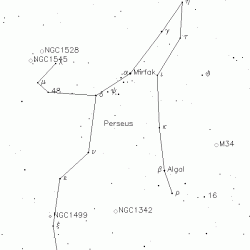With the Moon quickly departing early evening skies, now is the time to find a hero. Thanks to attention Comet 17/P Holmes has generated, many SkyWatchers have now become familiar with the constellation Perseus, but there’s a lot more there than just a comet! Only a few days ago, Holmes passed a wonderful bright star named Mirfak – a part of the Alpha Persei Association. Viewable with the unaided eye, but best in binoculars, this young, moving cluster is also known as Melotte 20 or Collinder 39 and is around 601 light years away. What a treat to catch a comet overlaying a star cluster!
But that’s not all… As the old year ends and a new one begins, Comet Holmes will sweep round to visit with Messier 34. At a little fainter than magnitude 5, you might be able to spot this 1400 light year distant star cluster as a hazy patch with just your eyes, but its full-moon size will make it a special treat in binoculars as Holmes passes it by!
As Comet Holmes continues to spread and dim, it will round its orbital turn and head towards a great variable star – Beta Persei. For readers, the “Demon Star” – Algol – is a familiar target, but what a treat to catch this eclipsing variable with the the comet by the last week of January 2008! Keep watching this 93 light year distant star, because as regular as clockwork – every 2.867 days – it will drop from magnitude 2.1 to magnitude 3.4 in matter of hours. To calculate Algol’s changes for yourself, try using this great interactive tool provided by Sky & Telescope: The Minima Of Algol. How fun to watch an eclipse that happens on such a regular basis!
But don’t stop watching just yet! While the comet will probably dim to telescope only range by mid-February, it’s going to slide its way past NGC 1342! This small, compressed, open cluster of stars is around 6.5 magnitude and well within binocular and small telescope range. Still not enough? Then hang on as Holmes continues takes a run for the west coast and slides by NGC 1499 – the “California Nebula” around the first week of March! If you’re able to view under very dark skies, the California Nebula can be seen unaided and in binoculars, but its low surface brightness makes it tough for a
telescope. What a great opportunity for astrophotographers!
Isn’t it time to make Perseus your hero?

